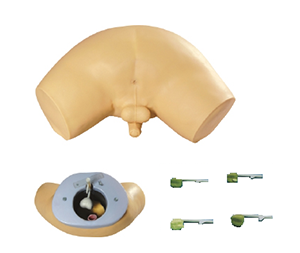Homepageпјҡ NEWS >> Can prostate screening models reduce errors in actual clinical practice?
Prostate screening is an important part of men's health management, especially in the early detection of prostate diseases such as BPH and prostate cancer. Although prostate palpation is a routine and effective examination in the clinic, due to the anatomical location of the prostate and its sensitivity to the examination procedure, improper operation can lead to misdiagnosis or patient discomfort. Therefore, how to improve the accuracy of prostate examination and reduce the error has become a major challenge in clinical practice. The application of prostate examination model, as an auxiliary teaching and clinical training tool, helps to reduce these errors and improve the results of examination. This paper will discuss the clinical application of prostate examination model, combined with industry expert views, data support and clinical significance, and analyze its potential to reduce operational errors.

Clinical significance of prostate examination model
Prostatic palpation is usually performed by a doctor with a digital rectal examination (DRE), which requires an accurate assessment of the prostate's anatomy, stiffness, shape, and size. However, due to the deeper position of the prostate and the complexity of palpation techniques, many doctors, especially beginners, often perform improper operations, resulting in a decrease in the accuracy of the examination results. This not only affects the diagnosis, but can also cause discomfort for patients and even increase the risk of diagnostic errors.
Data support: The effect of prostate examination model on reducing errors
According to a study on prostate exam education, physicians who used a prostate exam model for simulation training improved palpation accuracy by about 25% during actual clinical exams. The study also found that doctors trained with the model reduced the rate of misdiagnosis during palpation by more than 30 percent. The data show that the prostate examination model can significantly improve the doctor's mastery of prostate palpation, especially in the accurate positioning, evaluation of hardness, and identification of prostate abnormalities.
In addition, data from a survey of medical institutions showed that the introduction of the prostate examination model resulted in a significant reduction in the error rate of clinicians among newbie and intern physicians. For example, in the beginner group, the error diagnosis rate after model training was 20% lower than in the group that did not use the model. These data fully demonstrate the effectiveness of the prostate examination model in reducing errors and improving examination skills.
Expert opinion: The educational value of prostate examination models
Industry experts generally agree that prostate examination models have an important role in medical education. A leading urologist pointed out: "In the learning process of prostate palpation, clinical experience is essential, and the prostate examination model provides students with a safe and repeatable practice environment to effectively help them understand the anatomy of the prostate and master the correct palpation techniques."
The expert further mentioned that repeated training using the prostate examination model not only helps students and novice doctors improve their skills, but also helps them build confidence in palpation. In the absence of actual patients, doctors are free to practice, reducing mistakes caused by inexperience.
Summary
The application of prostate examination model in clinical practice can significantly reduce the error of operation and improve the accuracy of prostate examination. By simulating the real clinical environment, the model provides a safe and efficient learning platform for doctors to improve their palpation skills and clinical diagnosis ability. Both data support and expert opinions show that the prostate examination model can effectively reduce the misdiagnosis rate of novice doctors and interns in the actual operation, improve the accuracy of palpation, and ultimately help to improve the health management level of patients. With the continuous development of technology, prostate examination models will play an increasingly important role in medical education, clinical practice and future technological innovation